In this essential guide, we’ll explore some fantastic options for your June planting and provide tips for a bountiful garden in Zone 7.
Beans (Both Pole and Bush)
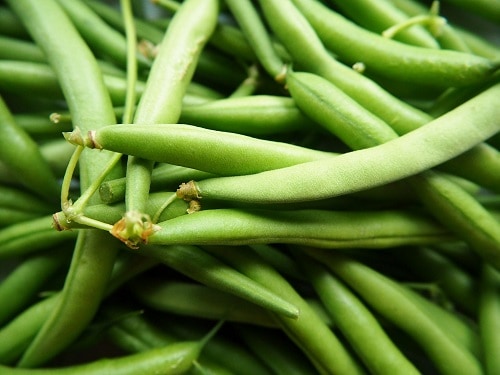
Beans are one of the easiest crops to plant in June, and they thrive in the warm soil typical of this time of year. There are two main types to consider: pole beans and bush beans. Pole beans need support to grow tall, making them a great option for vertical gardening, while bush beans are more compact and can grow without a trellis.
When planting beans, make sure to choose a location with full sun and well-draining soil. These legumes not only yield delicious pods but also enrich the soil with nitrogen, making them a beneficial addition to your garden. Common varieties include Blue Lake and Kentucky Wonder for bush beans and Scarlet Runner for pole beans. Plant them directly in the ground after the last frost, and you’ll enjoy a hearty crop by late summer!
Summer Squash
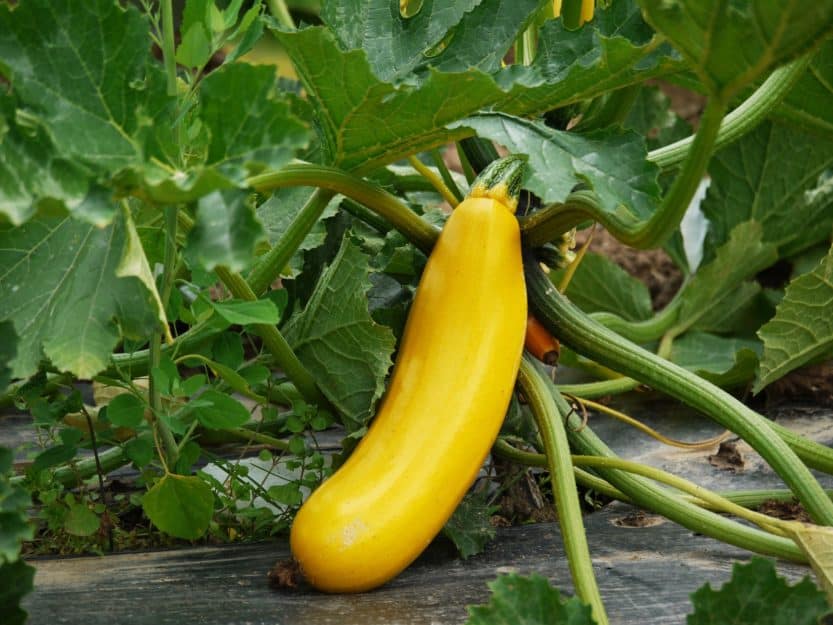
Summer squash, such as zucchini and yellow squash, is another excellent choice for June planting in Zone 7. These crops thrive in the heat, and with the soil temperature rising, they’ll germinate quickly. You can opt for either direct seeding or transplanting seedlings, depending on your timeline.
When selecting summer squash, look for varieties like ‘Yellow Crookneck’ or ‘Black Beauty Zucchini’. They not only produce a bountiful harvest but are also versatile for various recipes. Ensure they have enough room to spread out, as they can become bushy. Regular watering will keep the plants healthy, and a light layer of mulch can help maintain soil moisture.
Potatoes
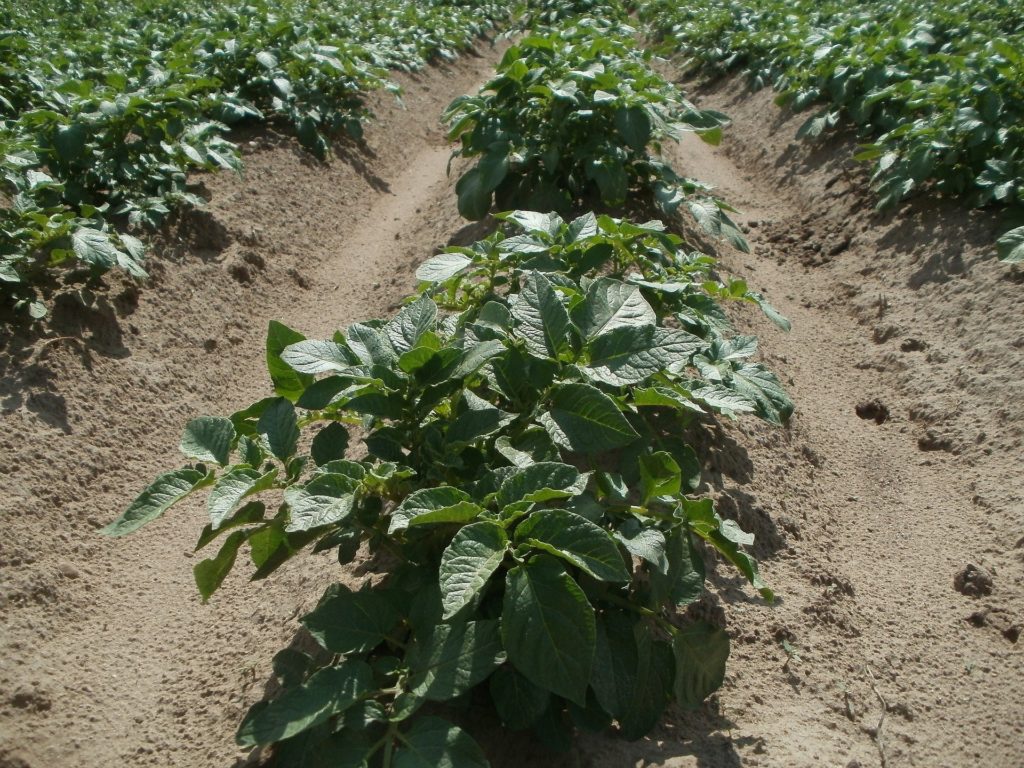
June is the time to plant late-season potatoes in Zone 7. If you missed an earlier planting window, don’t worry! This versatile tuber can still offer a good yield. Select seed potatoes from a reputable source and cut them into chunks, ensuring each piece has at least one eye.
Plant these pieces roughly a foot apart and a few inches deep in well-draining soil. Early varieties will need more care, while late ones could fare better with summer temperatures. Keep the soil consistently moist but not soggy, and be ready to hill the plants as they grow: this means adding more soil around the base of the plants for better tuber development.
Corn
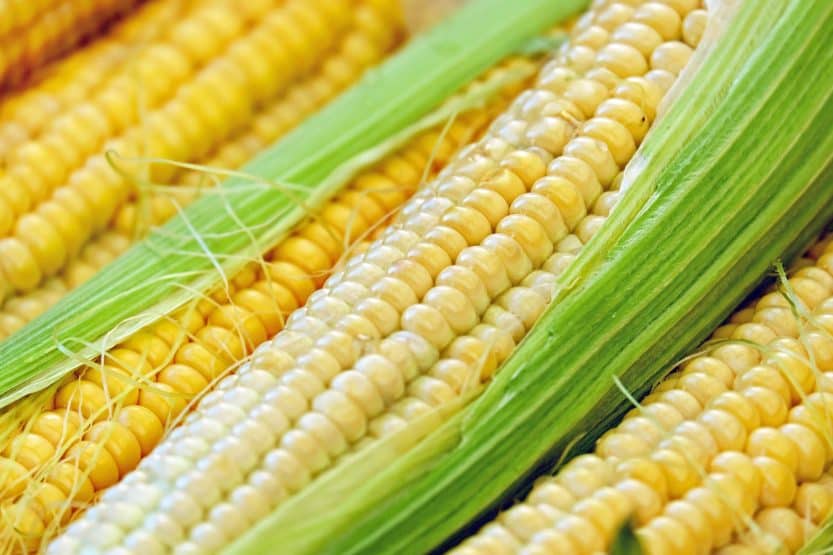
Corn is a summer staple that flourishes in hot weather. June is the perfect month to sow corn seeds directly into your garden beds. Make sure to plant them in blocks, as this helps with pollination, improving cob formation.
Choose varieties like ‘Silver Queen’ (a sweet corn) or ‘Trucker’s Favorite’ (a field corn) based on your needs. Corn requires rich, well-draining soil and consistent moisture – be sure to water deeply and regularly. Corn plants can grow quite tall, so providing them with space can lead to higher yields.
Popcorn
If you’re a fan of homemade popcorn, June is an ideal time to plant varieties that develop into popcorn cobs. Much like sweet corn, you will want to plant popcorn in blocks to ensure good pollination. Look for varieties like ‘Butterfly’ or ‘Zebra’.
Popcorn tends to require a bit more patience, taking approximately 100 days to reach maturity, so be sure to keep an eye on water needs during the growing season. As the plants grow, they will need ample sunshine and nutrients, so consider an organic fertilizer to promote healthy growth.
Cucumbers
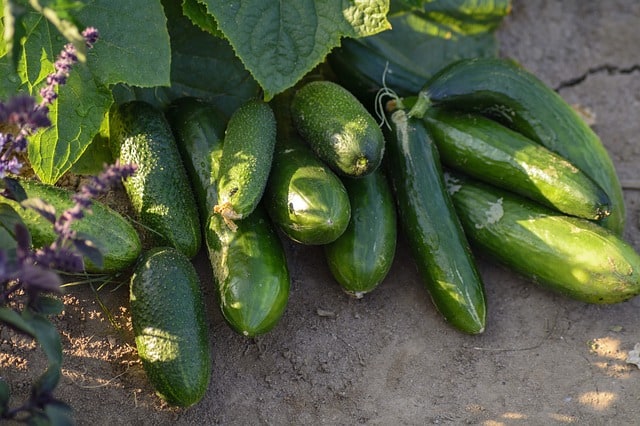
Cucumbers are perfect for the warm days of June and can be grown on trellises or allowed to sprawl across the ground. There are slicing varieties, such as ‘Marketmore’ and pickling varieties, like ‘Kirby’. Their crisp texture and refreshing taste make them a favorite across many dishes.
When planting cucumbers, choose a sunny spot with rich, well-draining soil. These plants require regular watering, particularly when the temperatures rise. Additionally, consider planting them near beans or sunflowers, as they can benefit from each other’s growth habits. Mulching around the base can help maintain moisture levels in the soil.
Determinate Tomatoes
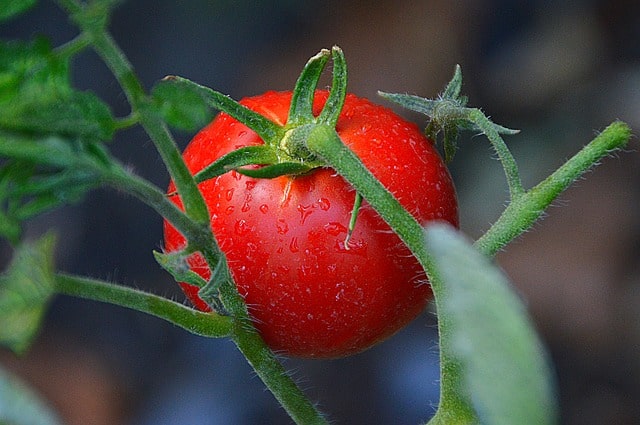
For those eager to enjoy homegrown tomatoes, June is a fantastic time to plant determinate tomato varieties. These tomatoes grow to a fixed size and often set fruit all at once, making them ideal for canning and preserving. Look for varieties such as ‘Roma’ or ‘Celebrity’.
Ensure you plant them in a spot that receives plenty of sunlight (at least 6-8 hours a day) and has nutrient-rich soil. Deep watering at the root level is essential, and adding mulch can help regulate soil temperature. As the plants grow, support them with cages to prevent sprawling, which can lead to diseases.
Melons
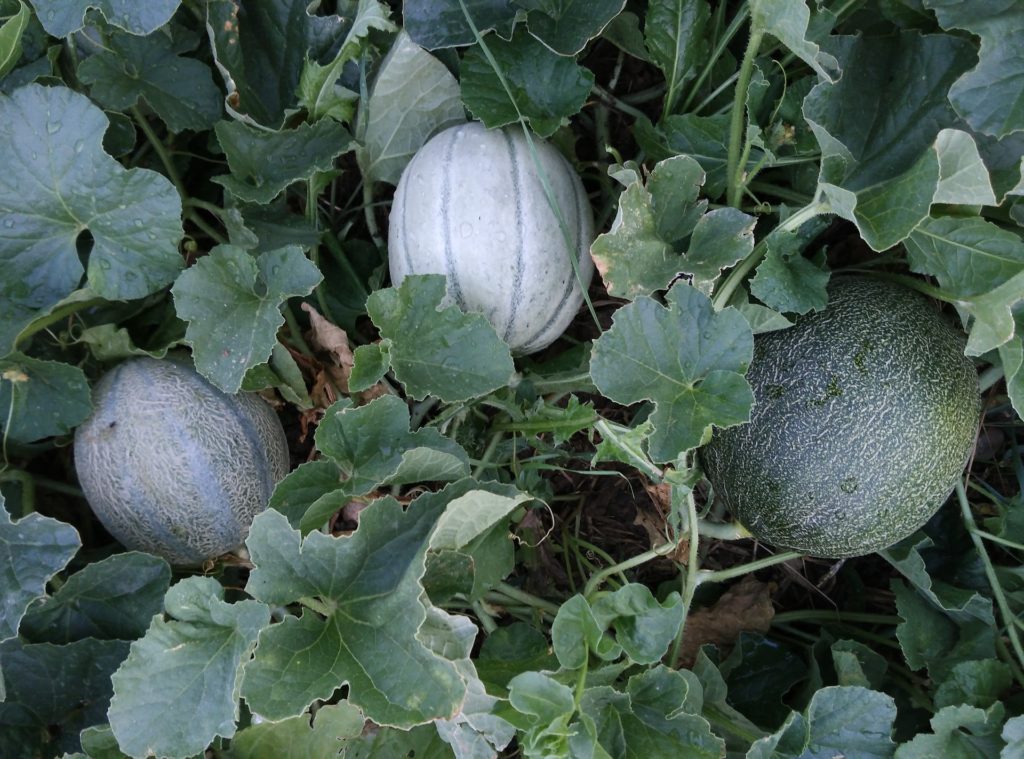
Melons are a delightful addition to any summer garden, and June provides the perfect climate for planting. Watermelons and cantaloupes thrive in the heat, and they love space to spread. Choose varieties that are well-suited to your region, such as ‘Sugar Baby’ for watermelon or ‘Hale’s Best’ for cantaloupe.
Plant seeds directly in the ground after the danger of frost has passed. Watermelons, in particular, require consistent moisture, especially as they begin to mature. Providing ample sunlight and nutrient-rich soil will enable sweet, juicy melons to thrive. If you’re short on space, consider growing small varieties in containers.
Kale

Kale thrives in cooler temperatures, which makes June an interesting time for planting, especially as the month progresses into summer. In Zone 7, you can start kale that will grow well through the fall. It’s a nutritious leafy green that provides continued harvest opportunities as you can pick the outer leaves while allowing the inner leaves to grow.
When planting kale, look for varieties such as ‘Lacinato’ or ‘Winterbor’, which can withstand heat better than others. Sow the seeds directly in the soil or opt for starting them in pots if you have a shorter time frame. Like other greens, kale enjoys full sun and regular watering for optimal growth.
New Zealand Spinach
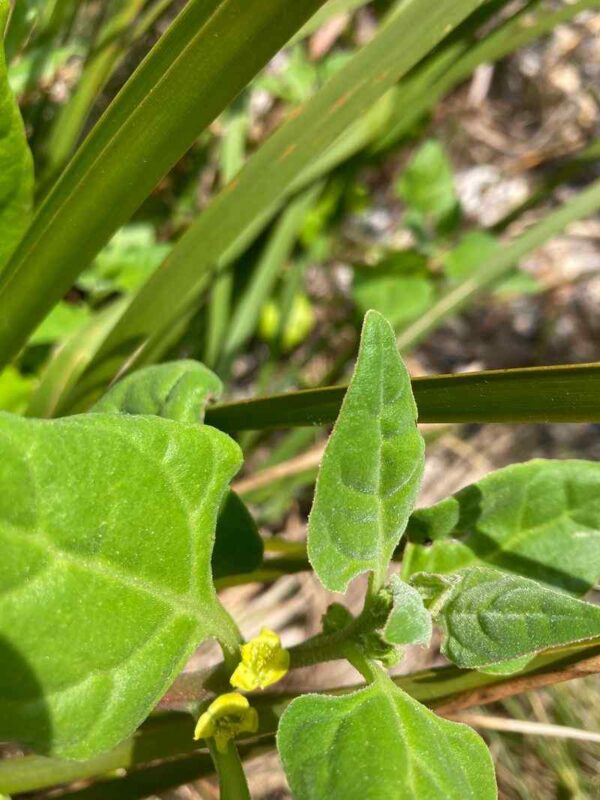
New Zealand spinach is a lesser-known leafy green that is excellent for warm summers. Unlike traditional spinach, this variety is heat-tolerant and can be sown directly in June. It can serve as a substitute for spinach in various dishes, providing similar flavors with a bit more resilience to soaring temperatures.
Plant the seeds in well-draining soil with ample sunlight and keep the soil moist. This spinach variant thrives and can extend your growing season since it produces leaves throughout the summer. Harvest regularly for continued growth, ensuring that the plant remains productive.
Malabar Spinach
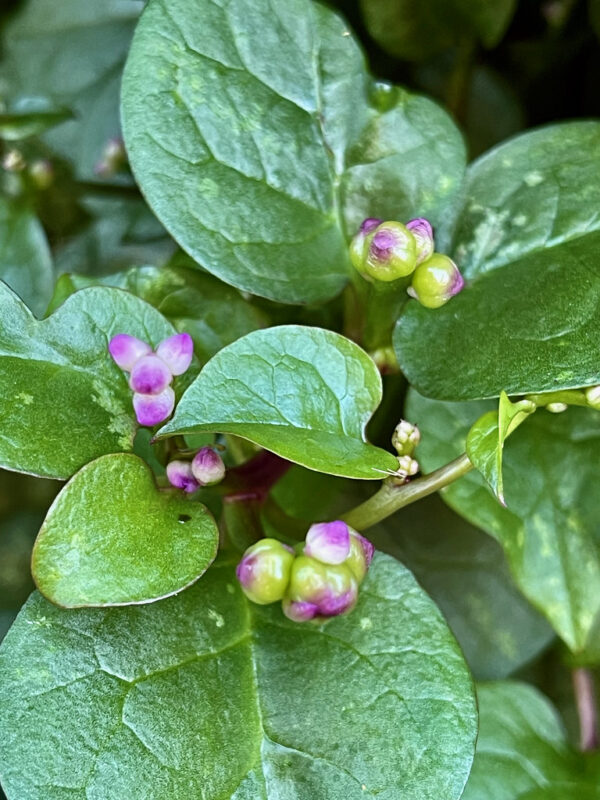
Malabar spinach, also known as Basella, is another unique option for the summer garden in Zone 7. This fast-growing, heat-tolerant plant offers succulent leaves and stems that are edible and rich in nutrients. Its climbing nature makes it ideal for trellises and vertical gardens.
Plant Malabar spinach after the last frost, choosing a sunny spot where it can grow vigorously. You can enjoy its leaves in salads or cooked dishes, and as it grows, it will create greenery that serves as an excellent backdrop for your garden. This is an excellent option for those who want a distinct and flavorful addition to their culinary repertoire.
June Planting List: Crops to Start Indoors
If you’ve got the indoor space, June is also a great time to start some crops indoors for a later transplant outdoors. This approach allows you to extend your growing season and ensure a cooler crop yield.
Broccoli

Broccoli is a fantastic cool-season crop that can be started indoors in June for a fall harvest. Seedlings can be transplanted outdoors in late summer, allowing them to thrive in the milder temperatures of autumn. When starting indoors, provide them with plenty of light and a heat mat if necessary, as they need warm conditions to germinate.
Transplant them to your garden when they have several true leaves, and ensure they are spaced adequately to encourage their growth. Keep the soil consistently moist to maintain healthy plants.
Brussels Sprouts
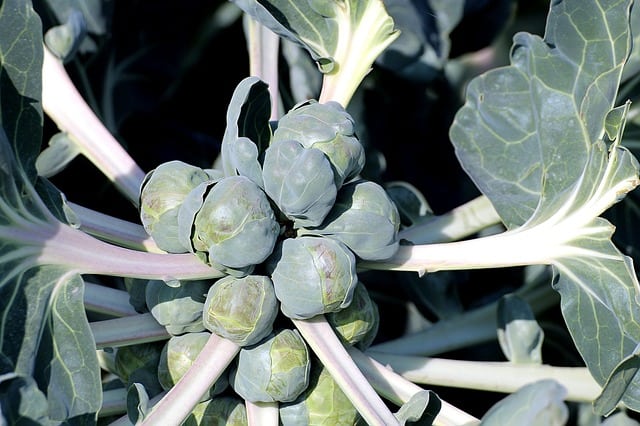
Like broccoli, Brussels sprouts benefit from a June indoor start. These hearty gems require a longer growing season, making the early start crucial. They thrive in cooler weather, so starting them indoors more quickly allows them to develop before the heat sets in.
Provide adequate space and nutrients during growth, and as they mature, you’ll enjoy a stunning harvest of these mini cabbages with a rich, nutty flavor.
Cabbage

Cabbage can also be started indoors in June for beautiful, firm heads in the fall. Like its cruciferous cousins, cabbage grows best in cooler weather, ensuring you’ll have a delicious crop ready before frost hits.
Use nutrient-rich soil for consistent germination and transplant at the appropriate time, making sure to space the plants out to allow for their expansive growth. Cabbage is versatile in the kitchen, making it a gardener’s staple.
Cauliflower
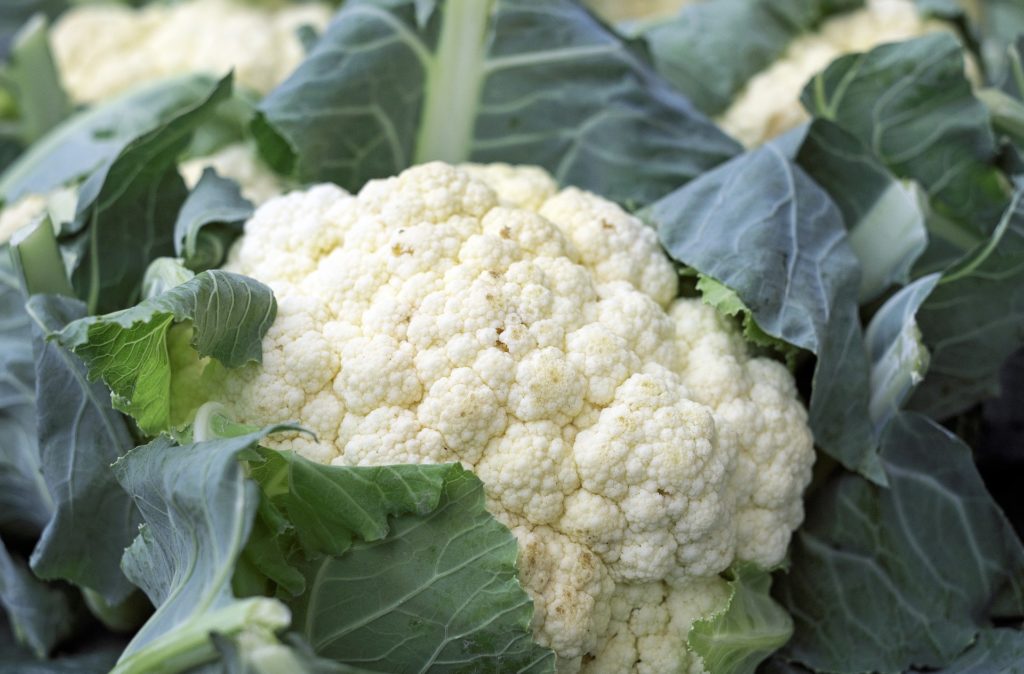
Cauliflower, another cruciferous vegetable, thrives with an early start indoors. This vegetable is known for its white heads that can be quite delicate. Plan your indoor germination in June, then harden the seedlings before transplanting outdoors.
Cauliflower requires consistent moisture and a nutrient-packed soil mix for optimal head formation. Be diligent with watering and you’ll reap the rewards of this rewarding crop.
Kale

In addition to directly sowing kale outdoors, starting it indoors allows you to control its environment and extend the harvest season. As mentioned earlier, kale can withstand cooler temperatures and thrive into the cooler months of fall.
Start the seeds indoors and transplant them once the seedlings are strong enough. This staggered approach helps maintain a regular supply throughout your growing season.
Kohlrabi
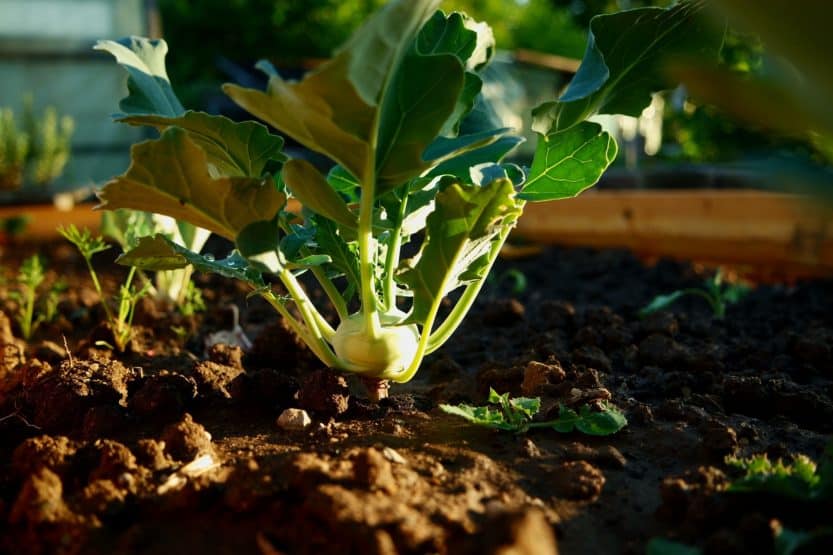
Kohlrabi is a less common vegetable that deserves to be included in your June planting plans. Start cabbage relatives indoors to grow the bulbous stems that are sweet and crisp. Its mild flavor makes it versatile in salads and stir-fries.
Transplant the seedlings when they are strong and be sure to provide them with good spacing. These chunky veggies can be harvested when they are smaller for the sweetest taste, so keep an eye on their growth.
Gaillardia (Blanket Flower)
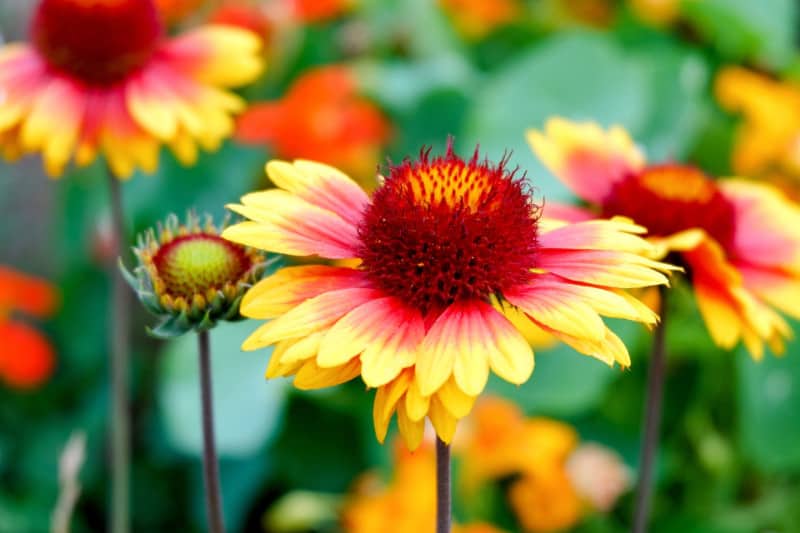
Gaillardia, commonly known as blanket flower, is loved for its daisy-like blooms, which feature brilliant colors ranging from red to gold. This perennial thrives in full sun and blooms from early summer to fall, making it a vibrant addition to any garden.
Gaillardia prefers well-drained soil and is drought-tolerant once established, which makes it perfect for low-maintenance gardens. Additionally, it attracts pollinators, including butterflies and bees, contributing to the health of your garden ecosystem. Plant them in clusters to create a bold color statement.
Butterfly Milkweed (Asclepias tuberosa)

Butterfly milkweed stands out not only for its striking orange flowers but also for its role in supporting local wildlife, especially monarch butterflies. This perennial is a must-have for any pollinator garden, providing nectar throughout the summer.
Planting butterfly milkweed in well-drained soil and full sun results in healthy growth. It thrives in dry, sandy conditions, making it ideal for xeriscaping. Additionally, the plant’s deep taproot allows it to survive in less than ideal conditions, another reason it’s resilient and beautiful.
Pentas (Egyptian Starflower)
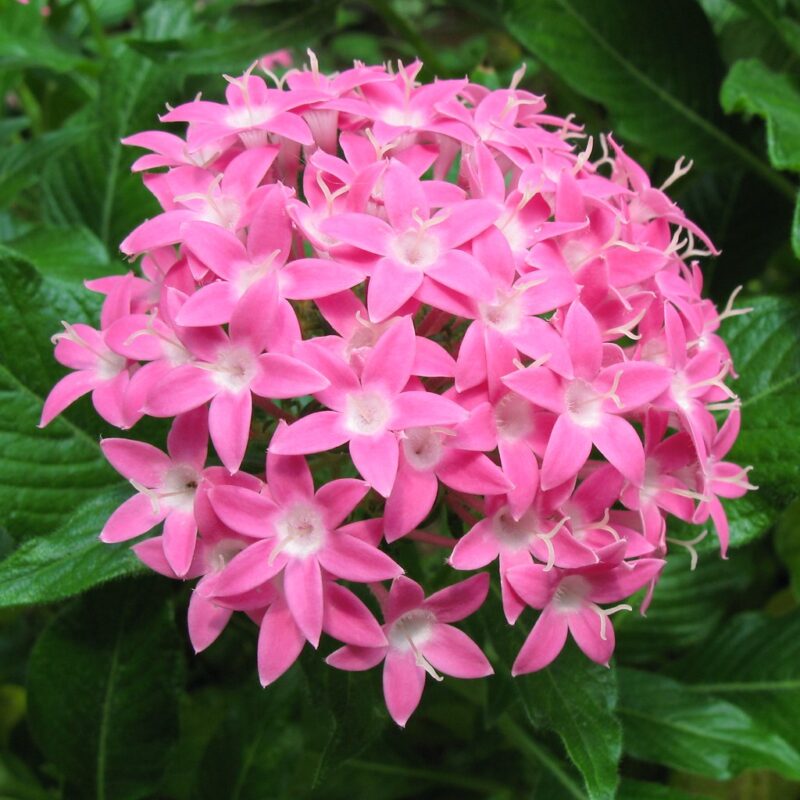
Pentas are well-loved for their star-shaped flowers that bloom in clusters and attract butterflies and hummingbirds. Often used in annual beds or borders, these plants come in vibrant shades of pink, red, white, and purple.
Pentas thrive in full sun and well-drained soil, requiring regular watering to establish a robust root system. They can be grown in containers, providing a lovely pop of color on patios or balconies, making them a versatile choice for any gardener.
Daylily (Hemerocallis)

Daylilies are a perennial favorite for many gardeners, known for their stunning, trumpet-shaped flowers that come in a variety of colors. Each blooming flower lasts only one day, hence the name, but they scatter their blooms across the summer months.
This resilient plant can adapt to various soil types and light conditions, although they thrive best in full sun and moderate water. Daylilies also boast impressive pest resistance, making them low-maintenance. Grouping different varieties can enhance their visual appeal and create a captivating display.
Begonia
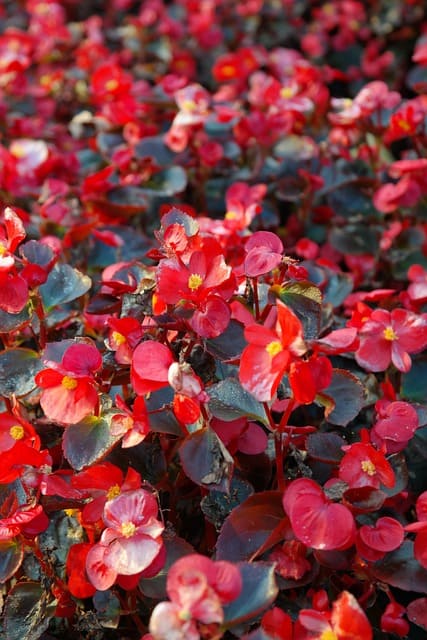
Begonias are ideal for adding vibrant color to shaded areas of your garden. Known for their ornamental foliage and stunning blooms, these annuals produce flowers in hues such as pink, red, orange, and white.
They prefer moist, well-drained soil and thrive in indirect sunlight. Regular deadheading promotes prolonged blooming, allowing you to enjoy their colorful display throughout the growing season. Begonias are excellent for containers and hanging baskets, creating a lush appearance.
Sea Holly (Eryngium)
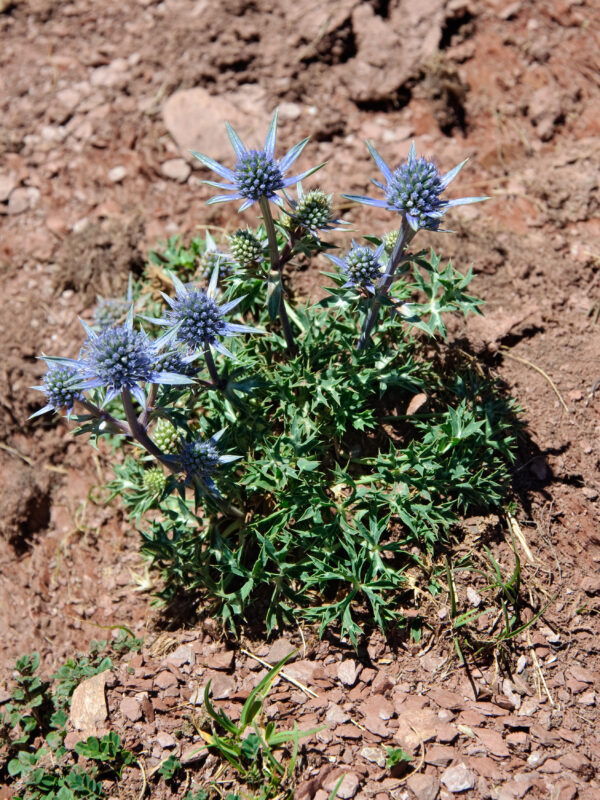
Sea holly is a unique perennial that adds a touch of whimsy to any garden with its spiky, metallic-blue flowers. This hardy plant thrives in well-drained soils and full sun, and it is ideal for drought-tolerant gardens.
Not only is sea holly visually stunning, but it’s also a magnet for bees and butterflies. Its unique structure can create interest in dried flower arrangements, extending its presence beyond the garden.
Verbena
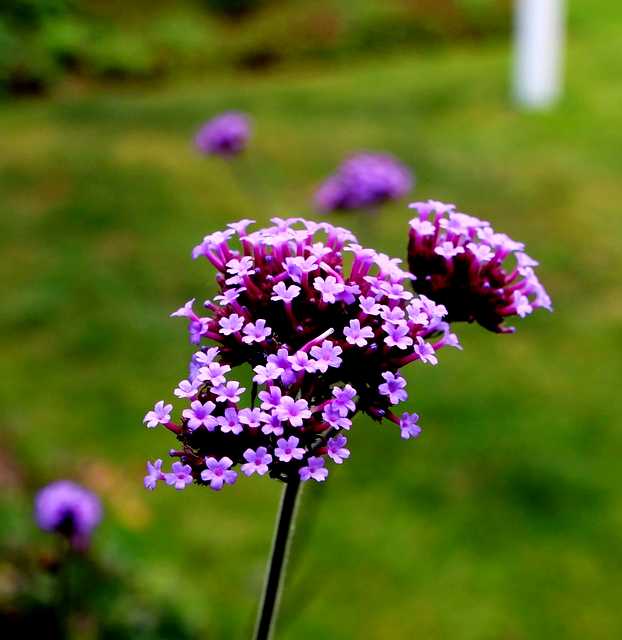
Verbena is a versatile annual that blooms in a variety of colors, such as purple, red, pink, and white. This plant is well-regarded for its resilience in sunny and warm conditions, making it a fantastic option for gardens needing vibrant color without much fuss.
Plant verbena in well-draining soil and ensure adequate sunlight for optimum growth. It can be grown as a ground cover or in containers, providing continuous blooms from spring until frost.
Melampodium (Butter Daisy)

Melampodium is an often-overlooked annual known for its cheerful yellow flowers and prolific blooming. This hardy plant thrives in hot, sunny conditions and flourishes in well-draining soil.
Melampodium is perfect for filling in gaps in flower beds or providing a vibrant burst of color along borders. Its low-growing habit makes it ideal as a ground cover, and it pairs beautifully with other flowering plants for a eye-catching composition.
Angelonia (Summer Snapdragon)
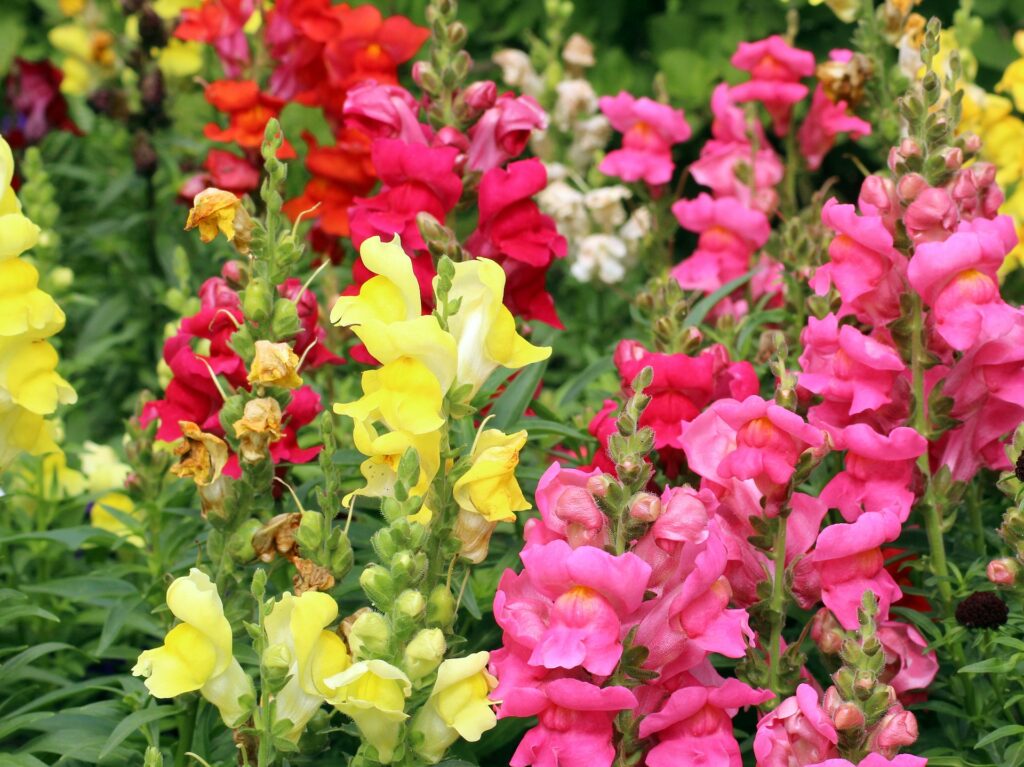
Angelonia, or summer snapdragon, brings elegance and beauty to gardens with its tall flower spikes and delicate blooms in shades of blue, purple, pink, and white. This annual is suitable for sunny locations, as it thrives in full sun and well-drained soil.
Resilient in heat and humidity, angelonia adds vertical interest to beds and borders. Its long-lasting blooms make it a perfect choice for containers, bringing an enduring splash of color to your patio or garden.
Gomphrena (Globe Amaranth)
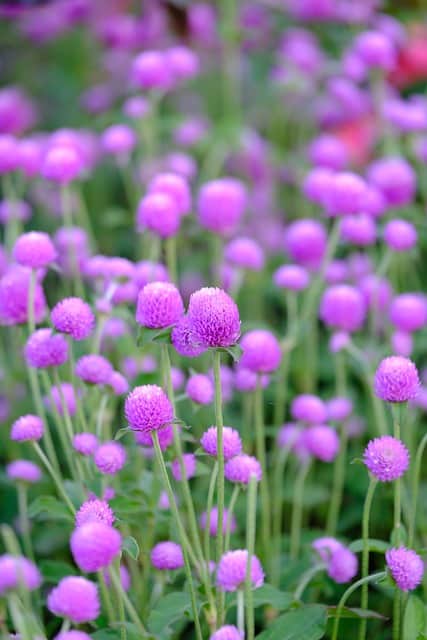
Gomphrena, often called globe amaranth, is a hardy annual that produces round, pom-pom-like flowers in colors such as pink, purple, and white. This drought-resistant plant thrives in well-drained soil and full sun.
Gomphrena’s unique flower shape and vibrant colors make it eye-catching in beds and borders. It also makes an excellent cut flower, holding its color well when dried, allowing you to enjoy its beauty year-round.
Canna (Canna Lily)
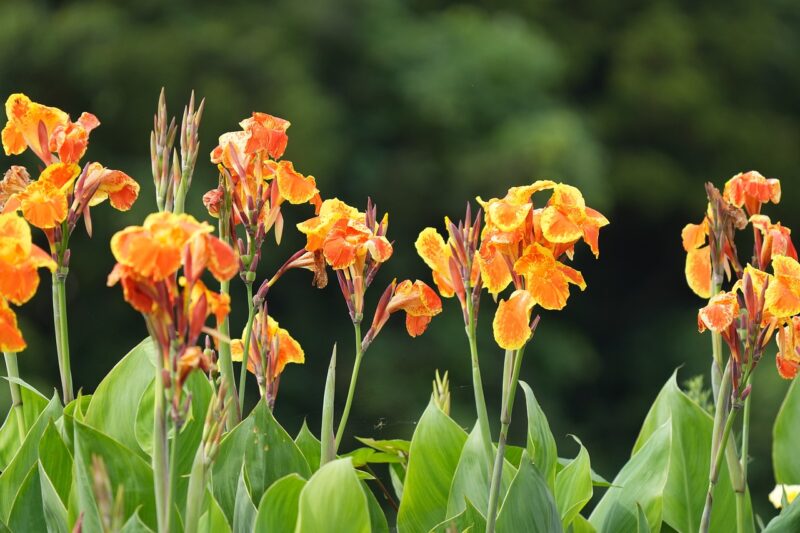
Canna lilies are known for their lush foliage and large, bright flowers that bloom throughout summer. Available in a wide range of colors, from yellows and oranges to reds, cannas can create a tropical look in your garden.
They prefer full sun and rich, well-drained soil, with regular moisture being crucial for vibrant growth. Cannas also thrive in containers, allowing for an exotic touch on patios or by poolsides. Their dramatic presence can transform bland areas into captivating spaces.
Balloon Flower (Platycodon grandiflorus)
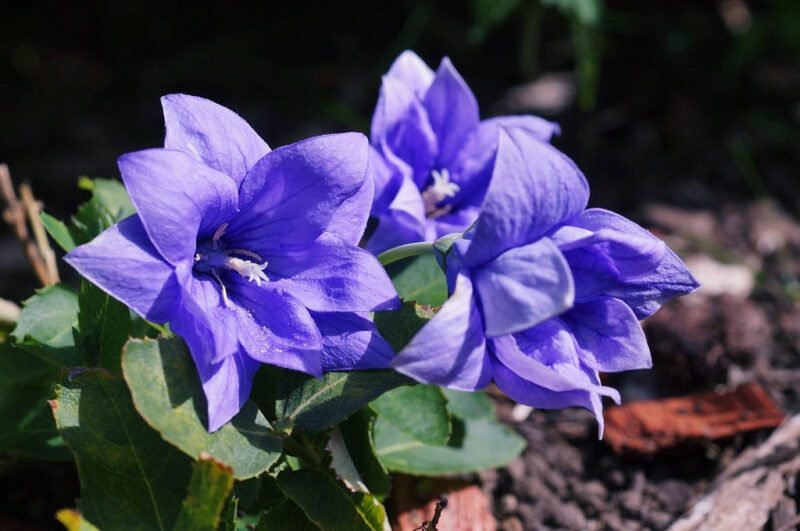
Balloon flowers are delightful perennials that present charming balloon-shaped buds that open into star-shaped flowers in shades of blue, pink, and white. They thrive in well-draining soil and full sun to partial shade.
This low-maintenance plant is perfect for borders or mixed flower beds, where its unique blooming habits can capture attention. Balloon flowers are also attractive to bees and butterflies, making them a pollinator-friendly choice.
Helenium (Sneezeweed)
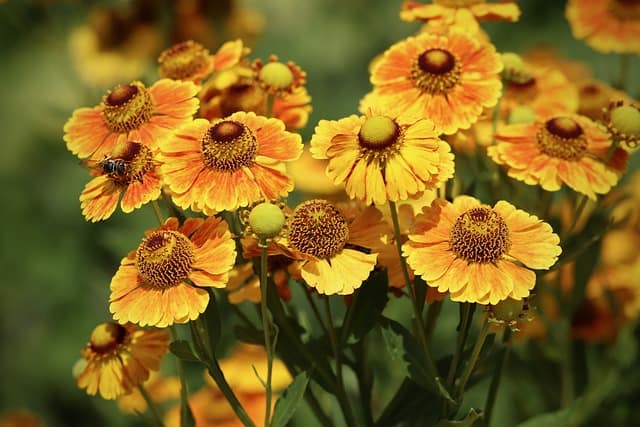
Helenium, or sneezeweed, is a perennial that adds a warm splash of color to any garden area. With daisy-like flowers in hues of yellow, orange, and red, these plants thrive in full sun and well-draining soil.
Helenium’s extended blooming period ensures your garden remains vibrant from late summer into fall. They attract butterflies and make excellent cut flowers, adding beauty to both your garden and home.
Impatiens
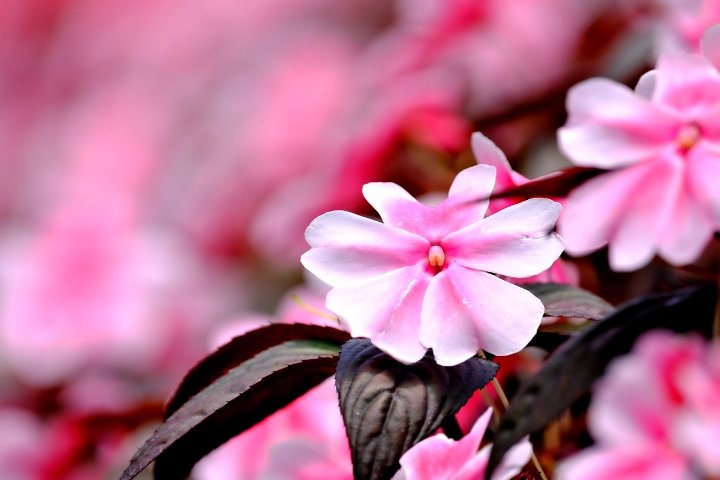
Impatiens are a favorite for shady areas of gardens, producing lush foliage and vibrant blossoms. Available in various colors, these annuals can brighten up any dull space.
Impatiens prefer well-drained, moist soil and do best when sheltered from direct midday sun. Their bushy growth habit makes them perfect for borders or container arrangements, providing an abundance of blooms all summer.
Sedum

Sedums are succulent perennials that are perfect for low-maintenance gardens. They come in a range of shapes and colors, from trailing ground covers to upright varieties, and are known for their ability to thrive in poor soil conditions.
Sedums require full sun and minimal water once established, making them ideal for xeriscaping. Their late-summer blooms attract pollinators, enhancing biodiversity in your garden.
Globe Thistle (Echinops)

Globe thistle is a stunning perennial known for its striking spherical flower heads, which appear in blues and purples. This drought-tolerant plant flourishes in well-drained soil and full sun.
Globe thistle stands tall in the garden, providing vertical interest and attracting bees and other pollinators. They work well in mixed borders, where their unique shape can create visual intrigue.
Lilies
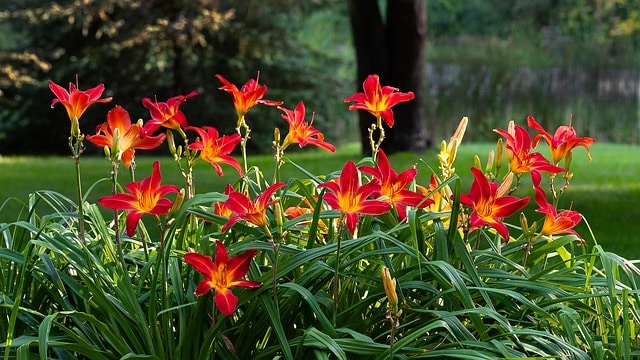
Lily bulbs are iconic in garden beds and borders, known for their extravagant blooms and fragrance. With many species and varieties, they range in color and size, offering something for every gardener.
Lilies thrive best in well-drained soil and prefer full sun to partial shade. While some varieties bloom in early summer, others bloom later in the season, allowing for staggered blooms and prolonged beauty.
Caladiums
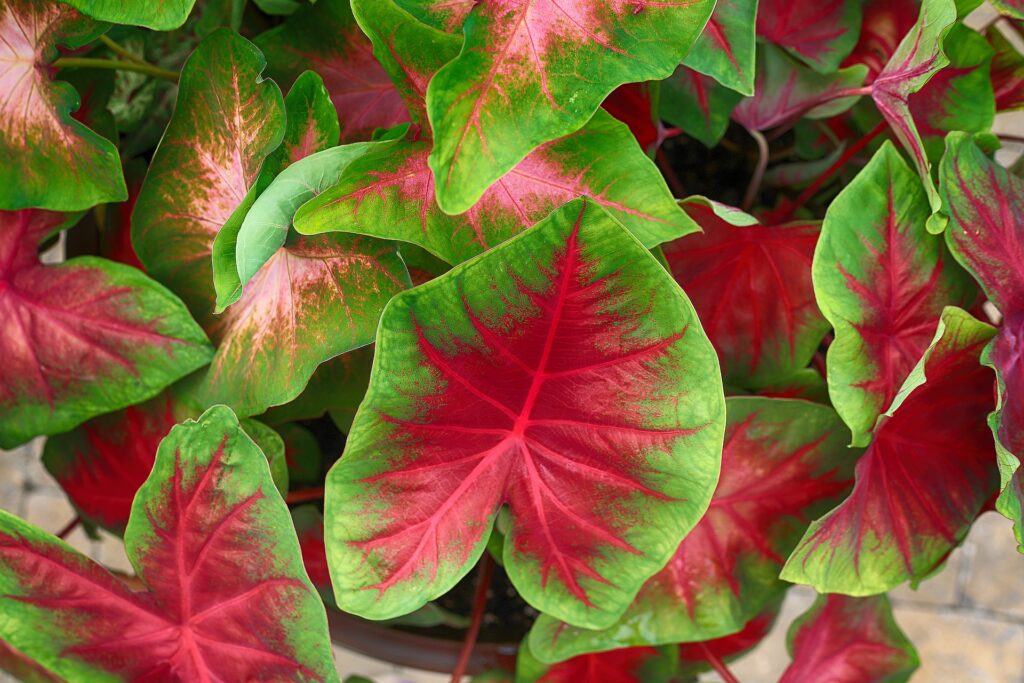
Caladiums are prized for their striking foliage, featuring heart-shaped leaves in shades of green, white, pink, and red. These annuals thrive in shady or partially shaded areas, making them excellent for brightening up darker corners of the garden.
Plant caladium tubers in rich, well-draining soil, and ensure they are watered regularly to keep their beautiful leaves looking vibrant. These plants are perfect for borders or containers, providing lushness and color where needed.
Geraniums
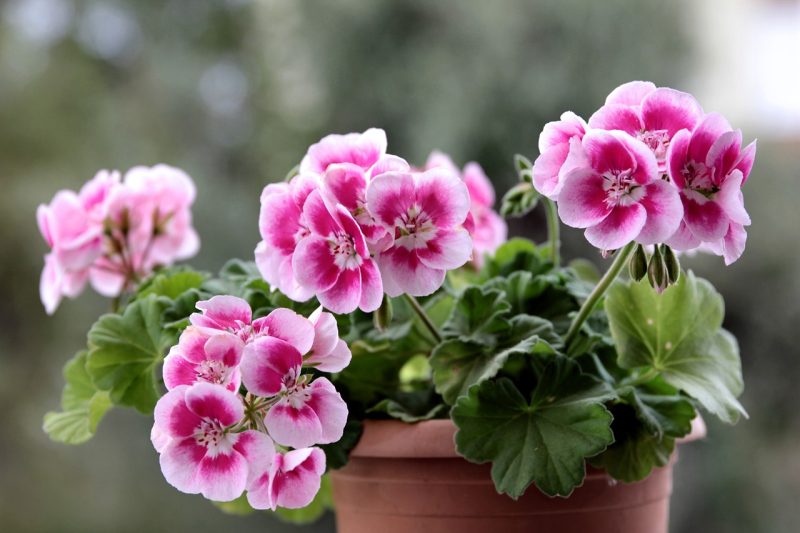
Geraniums are classic annuals that bring vibrant color to gardens and containers. Available in various colors and styles (including zonal, ivy, and scented types), they can suit any garden aesthetic.
Geraniums thrive in full sun with well-draining soil, requiring moderate watering. They can also be used in hanging baskets, producing beautiful cascading displays that beautify patios and decks.
Torenia (Wishbone Flower)
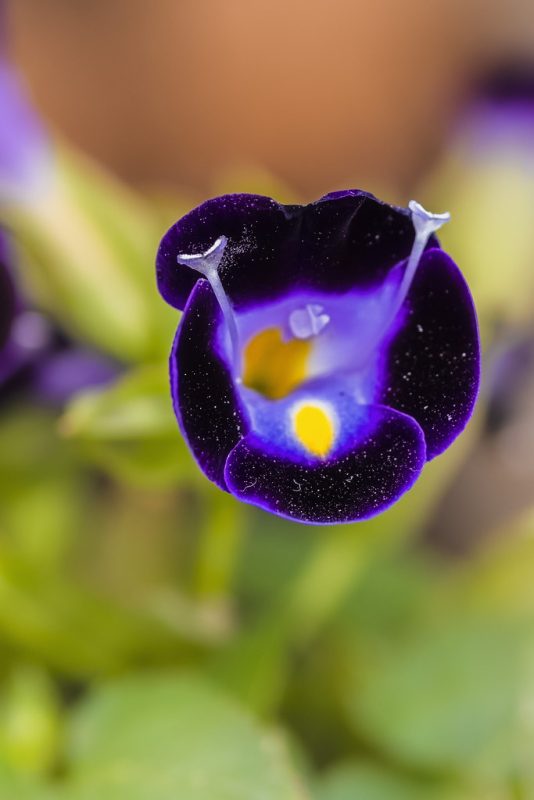
Torenia, also known as wishbone flower, is a charming annual that displays unique, tubular flowers in shades of blue, purple, and white. This plant prefers partial shade and moist, well-drained soil.
Torenia is excellent for containers and hanging baskets, adding touches of color to shaded areas. These hardy plants offer long-lasting blooms, making them a favorite for gardeners looking to create lush, vibrant displays.






